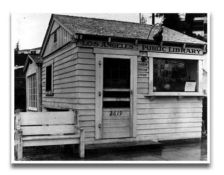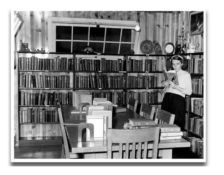
Walt in Wonderland: The Silent Films of Walt Disney by Russel Merritt and J.B. Kaufman. 1994, 176 pages (paperback released in 2000).
by Russel Merritt and J.B. Kaufman. 1994, 176 pages (paperback released in 2000).
Lafflets.
Tommy Tucker's Tooth.
Martha.
Alice.
Oswald.
Before Mickey Mouse, these were the characters and films that represented the Disney name. You might be familiar with some of them and a few of them are only known through production notes, stills and roughed-out sketches. Merritt and Kaufman's book is a historical, critical and very satisfying look at the silent films of Walt Disney. It might sound fairly flat to read an entire book on silent films, but it is engaging and very well-written. Not only will you gain insight into the creativity and themes that developed in the first films, but you will come away with a better understanding of the Company and early animation.
Russell Merritt, PhD., is currently an Adjunct Professor of Film Studies at UC Berkley. In addition to his writings on the silent films and Silly Symphonies of the Disney Company, he is considered an authority on D.W. Griffith. J. B. Kaufman is an independent film historian who has published extensively on Disney animation.







This title examines all of the known silent films produced by Walt Disney. Starting with the earliest work in Kansas City (1921) to the beginnings of Mickey Mouse (1928). This is the quintessential look at Walt's silent films and should be in every researcher's library. The authors have created a singular treatise on the evolution of Disney animated films from silence to sound.
In addition to covering the films, Walt In Wonderland is a fairly in-depth look at the beginnings of Walt Disney Productions. From the Kansas City Film Ad to Laugh-O-Gram Films to the first Disney Brothers' Studio on Kingswell Avenue. There are stills from most of the films and a plethora of historical photos of Disney during his first years in the animation field. Scattered throughout the book are production sketches, scripts and early storyboards.
There are four main sections covered in the book: the importance of The Cat and Rabbit Years, the Kansas City Period, Alice Comedies and Oswald the Lucky Rabbit. Each section looks in frank detail at the animation and state of the studio at the time. Often underlined is the importance of certain works in the overall scheme of the Disney creative canon.
Included is a complete list of all of the silent films made by Walt Disney from 1921 to 1928. Many times, the only information available was from eyewitness testimonies, sketches, summary sheets and the collection of private individuals.
It is hard to look at Disney's work in silent animation apart from the blinding afterimage of Mickey Mouse, the Silly Symphonies, and Disney's subsequent productions. Inevitably, the associations with Disney, the reinventor of fairy tales and amusement parks, the ubiquitous purveyor of American sweetness and light, affect what we look for when we watch the earliest films. Where did it all come from? Where are the clues that reveal Mickey and Snow White lurking in the wings? Were those bourgeois values always there, lurking below the surface like some Faustian devil, or did they only come later with prosperity and creeping middle age?Merritt and Kaufman do a fantastic job of answering the questions they pose. You will leave this book with a much greater and deeper appreciation for the strides made by Disney and his collaborators.
--p. 14.











0 comments:
Post a Comment